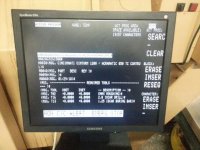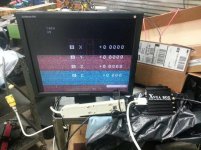Mud
Diamond
- Joined
- May 20, 2002
- Location
- South Central PA
Here's the short version - I bought a universal CNC video converter from Gonbes in China. There are other sources but Gonbes seems to be the manufacturer or distributor. I can't get good video from it and Gonbes has been not help. Has anyone here used one and had good results? I've seen them mentioned but never much information along with the mention.
I connected this one first to a Dynapath Delta 20 that has composite monochrome video output, and connected a standard Samsung 19" VGA monitor to the adapter. Things looked good at first, but when I changed screens in the CNC, the first screen stayed on display and the second screen showed up also, slightly dimmer. Changing screens on the CNC would change the ghosted screen, but not remove the first screen. The only way to get a second screen to display clearly is to power down the converter wait a few minutes and power it up again. Then you can see whatever screen is output as the primary display. Changing to another screen again shows 2 screens.
Adjusting the input parameters in the setup menu makes a mess of the display, eventually displaying garbage that won't go away until the converter is powered down and allowed to rest. Reconnecting it too soon just shows the garbage screens again. The longer power is connected the worse the display gets, and the only fix is to power down and walk away for 1/2 hour or more. I tried a completely different vga monitor (A/R and size) with the same result
Gonbes blamed this on the Dynapath control, saying it was not compatible with the converter and telling me to get a technician to test the video frequency with a scope, or a mulitmeter. I have a mulitmeter with a frequency capability, but no way to separate the H and V frequencies. so that's useless. The converter is rated for 12 to 40 Khz H frequency. The Dynapath is 20-21, the Deckel is 15.64, the cincinnati is 15.82.
So I connected it to 2 other CNCs to test it, a Deckel Dialog 4 and a Cincinnati 850. The Deckel has a composite output on the bottom of the control console intended to connect to an external monitor and should be quite easy to convert, the Cincinnati 850 has an internal composite connection from the motherboard to the display in the operator console.
I got the same results from both of those controls. Photos attached.
I've been beating this to death for a month, Gonbes has been no help except to request more tests and experiments like adding ground wires. They insist their converter is not defective and that all three of my controls are the problem. They offered to refund half my purchase price and suggested I should sell it to someone else that can use it.
So I filed a paypal case. Gonbes offered to refund my purchase price less shipping and paypal fees IF I withdraw the paypal case AND destroy the adapter first and send them photos of it destroyed. I then escalated the case to paypal for resolution, they made the same offer of purchase price refund only, I have until 3/15 to accept that or refuse it and see what paypal decides to do. The difference is only about $25, but I'm REAL annoyed about all the time I've wasted over the past month on this and the zero help I've received and I'm in the mood to beat this dead horse to pulp.
So gentlemen of PM, has anyone here used a converter like this successfully? What do you think is happening here, and what do I need to do to get a VGA monitor working on one of these machines? Is there something I'm completely missing about this? The Dynapath is old and getting really hard to see the monitor on (monitor faces a bank of windows) and a larger one would make the machine much nicer to run. The Deckel monitor is working fine, but a larger secondary screen would make the machine much nicer to operate because it's a large machine and we're often fairly far from the console using a remote handwheel. I'm attaching a few photos to show what happens, If they aren't clear I have LOTS more photos.
More photos in the next post.





I connected this one first to a Dynapath Delta 20 that has composite monochrome video output, and connected a standard Samsung 19" VGA monitor to the adapter. Things looked good at first, but when I changed screens in the CNC, the first screen stayed on display and the second screen showed up also, slightly dimmer. Changing screens on the CNC would change the ghosted screen, but not remove the first screen. The only way to get a second screen to display clearly is to power down the converter wait a few minutes and power it up again. Then you can see whatever screen is output as the primary display. Changing to another screen again shows 2 screens.
Adjusting the input parameters in the setup menu makes a mess of the display, eventually displaying garbage that won't go away until the converter is powered down and allowed to rest. Reconnecting it too soon just shows the garbage screens again. The longer power is connected the worse the display gets, and the only fix is to power down and walk away for 1/2 hour or more. I tried a completely different vga monitor (A/R and size) with the same result
Gonbes blamed this on the Dynapath control, saying it was not compatible with the converter and telling me to get a technician to test the video frequency with a scope, or a mulitmeter. I have a mulitmeter with a frequency capability, but no way to separate the H and V frequencies. so that's useless. The converter is rated for 12 to 40 Khz H frequency. The Dynapath is 20-21, the Deckel is 15.64, the cincinnati is 15.82.
So I connected it to 2 other CNCs to test it, a Deckel Dialog 4 and a Cincinnati 850. The Deckel has a composite output on the bottom of the control console intended to connect to an external monitor and should be quite easy to convert, the Cincinnati 850 has an internal composite connection from the motherboard to the display in the operator console.
I got the same results from both of those controls. Photos attached.
I've been beating this to death for a month, Gonbes has been no help except to request more tests and experiments like adding ground wires. They insist their converter is not defective and that all three of my controls are the problem. They offered to refund half my purchase price and suggested I should sell it to someone else that can use it.
So I filed a paypal case. Gonbes offered to refund my purchase price less shipping and paypal fees IF I withdraw the paypal case AND destroy the adapter first and send them photos of it destroyed. I then escalated the case to paypal for resolution, they made the same offer of purchase price refund only, I have until 3/15 to accept that or refuse it and see what paypal decides to do. The difference is only about $25, but I'm REAL annoyed about all the time I've wasted over the past month on this and the zero help I've received and I'm in the mood to beat this dead horse to pulp.
So gentlemen of PM, has anyone here used a converter like this successfully? What do you think is happening here, and what do I need to do to get a VGA monitor working on one of these machines? Is there something I'm completely missing about this? The Dynapath is old and getting really hard to see the monitor on (monitor faces a bank of windows) and a larger one would make the machine much nicer to run. The Deckel monitor is working fine, but a larger secondary screen would make the machine much nicer to operate because it's a large machine and we're often fairly far from the console using a remote handwheel. I'm attaching a few photos to show what happens, If they aren't clear I have LOTS more photos.
More photos in the next post.













